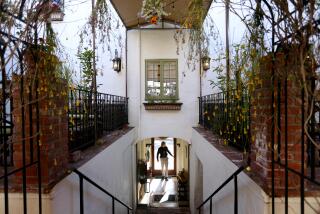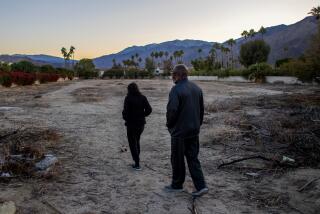Former Planner Claims Bernson Porter Ranch Mailer Flawed : Campaign: A spokesman for the councilman rejects the criticism. He says Calvin Hamilton is ‘on the payroll’ of a homeowners group opposed to the huge development.
- Share via
In an unusual critique, Los Angeles’ former planning director has questioned the accuracy of a campaign brochure favorably describing the mammoth Porter Ranch development that City Councilman Hal Bernson mailed to thousands of voters.
Calvin Hamilton, who served as city planning chief for 22 years, said Bernson’s brochure was inaccurate and misleading on a number of points. The mailer compared the Porter Ranch plan approved by the council last year to a 1974 plan developed by Hamilton.
“Because the new plan was conceived by developers, the controls are weighted strongly in favor of those developers and builders, unlike the 1974 plan which permitted more extensive citizen input,” Hamilton said.
But a Bernson spokesman charged that Hamilton was “on the payroll” of the PRIDE homeowners group, which has long opposed Porter Ranch and last year filed an unsuccessful lawsuit against the project.
“He’s being paid by PRIDE or some of their people,” said Bernson spokesman Greig Smith. “He’s not exactly speaking from an unbiased perspective. He’s paid to say those things.”
Hamilton said he reviewed Bernson’s brochure at the request of Leonard Shapiro, one of five candidates running against the councilman in Tuesday’s city elections. Shapiro, a Granada Hills retiree who publishes a monthly newsletter about city government, said he intends to print Hamilton’s analysis in a future issue. Shapiro said he did not pay Hamilton for the review.
PRIDE leader Don Worsham said Hamilton was “never paid a penny” by his group. However, Hamilton said he was paid $90 by another homeowners group, the Northridge Civic Assn., to prepare an analysis of Porter Ranch. Worsham said PRIDE was later given that material for free.
Another candidate for Bernson’s seat who is also a PRIDE leader, businessman Walter Prince, said he paid Hamilton $100-$150 last year to separately review a city environmental assessment of the development. Prince said the work was done for him, not PRIDE.
Porter Ranch has emerged as the central issue in Bernson’s campaign for reelection. His opponents have repeatedly attacked him for his support of the development. They also have questioned the ethics of his acceptance of more than $55,000 in campaign contributions from developer Nathan Shapell and his business associates since 1982.
Under the current plan, Shapell will build nearly 3,400 housing units in the rolling hills north of Chatsworth. The development, which will not be finished for 20 years or more, includes 850 hotel rooms and a regional shopping center. Shapell already has built or won city permission to build 6,000 dwellings in the Porter Ranch area but outside the boundaries of the development.
In his brochure, Bernson compared the present Porter Ranch Specific Plan--a precise blueprint for developing the 1,300-acre project--with the 1974 Chatsworth-Porter Ranch District Plan. The earlier plan outlined broad development guidelines for all of Porter Ranch and Chatsworth.
Bernson claimed the new plan is superior because it allows fewer dwellings and less commercial space, while providing such amenities as a new fire station, equestrian trails and child-care facilities.
His brochure said the new plan is “a much more comprehensive plan that is environmentally sensitive and economically sound.” Much of the new document was written by a citizens advisory group appointed by Bernson.
Smith said the information in Bernson’s brochure was taken from city records and is “totally accurate.”
But Hamilton disputed a number of assertions in the mailer, which was sent to voters last month.
The former planning chief said that, contrary to Bernson’s claim that the 1974 plan called for 4,232 dwelling units, it recommended only 2,430. Hamilton said, however, that the old plan also said additional units could be constructed in a corridor along the Simi Valley Freeway over a 20-year period if they were deemed necessary.
The councilman’s mailer stated that under the new plan, 1.5 million square feet of commercial space could be constructed before a new traffic congestion study has to be conducted. Under Hamilton’s plan, the brochure said, 4 million square feet could be built before the traffic study was triggered.
Hamilton disagreed with that. He said his plan did not specify any square-footage figures for commercial space. Instead, it provided that commercial development take place on 450 acres in the area of the Northridge Fashion Mall and near the intersection of Devonshire Street and Topanga Canyon Boulevard in Chatsworth.
“We were very concerned to protect the beauty of Porter Ranch and not make it a great big, ugly development,” Hamilton said in a telephone interview.
Smith conceded the figure of 4 million square feet was “a guess” based on the commercial acreage mentioned in the old plan.
But he added that the Hamilton plan’s guidelines for commercial development in Chatsworth would have “destroyed an existing community.” In response, Bernson’s advisory committee altered the plan so that the bulk of the commercial construction would be within the Porter Ranch development, Smith said.
Hamilton also disputed Bernson’s suggestion that the 1974 plan did not provide for the construction of a fire station and day-care facilities or for the burial of high-tension wires.
He said that although such amenities were not specifically mentioned in the old district plan, they were required at the time under the city’s General Plan and related laws.
Hamilton said that while the new plan has some good features, it is “not as comprehensive.”
He said Bernson’s advisory group “is much more a business- and developer-oriented group” than was the group that assembled the 1974 plan. Smith disagreed, saying Bernson’s group is broad-based and includes one of the councilman’s political opponents.
Hamilton resigned his planning job in 1985 under pressure from top city officials, including Mayor Tom Bradley.
Bradley and other officials regarded Hamilton, then 60, as an imaginative planner who lacked the practical and political skills to convert ideas into policy at a time when the city was struggling to accommodate growth.
Hamilton was criticized by homeowners for the city’s failure to enact its General Plan and by developers for not heading off a homeowners’ lawsuit that culminated in a mandatory rezoning program they feared would place thousands of acres of city land off-limits to development.
Ironically, the General Plan was Hamilton’s conception and, many people believe, his finest achievement.
More to Read
Sign up for Essential California
The most important California stories and recommendations in your inbox every morning.
You may occasionally receive promotional content from the Los Angeles Times.













